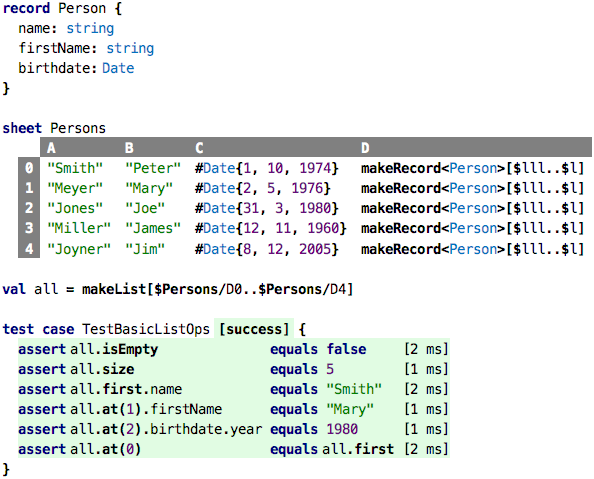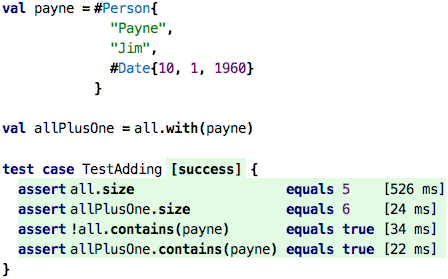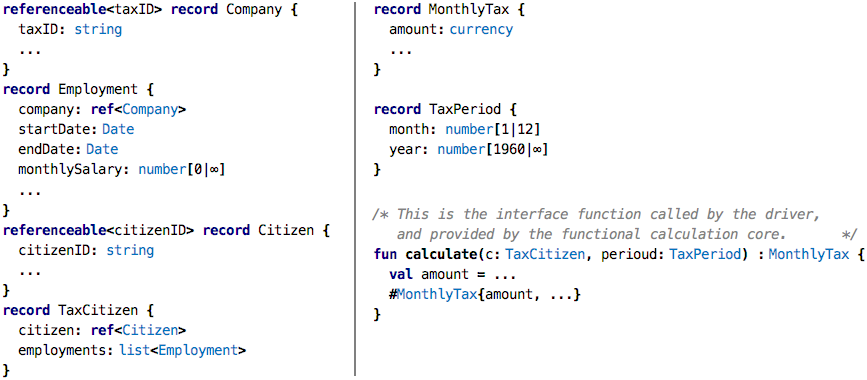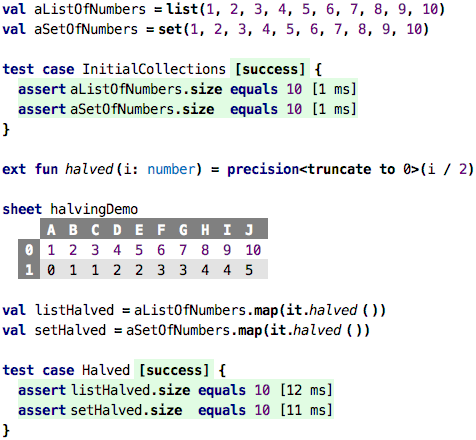Go back to Structured Values
Chapter 06: Collections
Motivation
In the previous chapter we have discussed records. A record combines several
values into a new abstraction. For example, values name: string, first: string
and birthdate: Date are combined into a record Person. Collections are also
abstractions that combine several values, but they are different from records in
the following ways:
-
Records group values of different types (
string+string+Datein the example above), whereas collections group values of the same type. -
In Records, each value is identified by a name, whereas in collections, the values are anonymous, possibly identified by their position (“the 3rd element in a list”)
-
In a record, there is a fixed set of values (
name,first,birthdate), whereas in collections the number is (usually) not limited. -
Finally, records are specific declarations; we defined the
Personrecord to suit our particular needs. Collections are generic, i.e., they are predefined and we just use them.
The reason for having collections is rather obvious: if we look at the PatientData example from the previous chapter, it’s rather strange to
only have one blood pressure value. More realistically, you would probably
want to collect several blood pressure measurements to represent how a person’s blood pressure evolves over time. Similarly, the introductory example from the last chapter …
… can of course also be seen as a list of five records. We want to have an abstraction that allows us to work with collections such as lists, sets or maps.
Introduction to Lists
To get started, let us define a list of 5 integers:
We define a value, as usual, but that value represents a whole list of
other values, in this case, the ages from column A of the spreadsheet
above. What is the type of this thing? Let’s see what the type system
automatically infers:
Wow, that is a rather complex type! Let’s see. It is a list. Inside the
<...> it specifies the type of the elements of that list. In this case, all
elements are (integer) numbers, and as we can see by analyzing the
values, the number is between 12 and 87, the smallest and the largest of
the values in the list. In the square brackets behind the angle
brackets, the minimum and maximum length of the list is defined. Since
we derived the type from the list value that had exactly five elements,
the length is also be derived to be exactly five. Let’s see what happens
if we generalize the type:
Here, we have manually specified the type (i.e., we have changed
the program by editing it) to just be a list of
numbers; no number range, and no list length. This is still a valid program
in terms of types.
Remember that earlier we said that for a val declaration, the type of
the value (list(45, 33, 12, 87, 56)) must be the same or a subtype of
the specified type (if one is specified). This is intuitively the case
here: numbers between 12 and 87 are clearly a subtype of numbers in
general, and a list with five elements is a subtype of a list with an
arbitrary length.
The fact that a
list<U>is a subtype oflist<T>ifUis a subtype ofTis a feature called covariance. So, in our language here, lists are covariant. They don’t have to be, the language (and its type system) could have been defined differently; however, covariance for collections is rather widespread and also makes intuitive sence.
So in the code above, we see the word “list” twice. Behind the colon it
is used as a type, similar to number or Person. What is special
about this type is that it also specifies the type of the elements
in the list between the angle brackets. This is new: one type (list)
has a second type (number) as a parameter. We will return to this
below. The second use of list is behind the equals sign. As we know
from earlier examples, we expect an expression there. So the list(a, b,
...) is an expression that constructs a new list. The elements of the
list are given in parentheses. If it is supposed to be an empty list,
you can leave the list of elements empty. However, then you have to
specify the type of the elements explictly (because the type system
cannot derive it from the elements). Here is an empty list of strings:
There are of course other ways of creating lists. Below we will see how
to create new lists by adding or removing elements from an existing
list. However, we can also construct completely new lists in other ways
than with the list expression. Here is a way to construct a list from
a linear range of cells in spreadsheet:
Each row in the sheet, in row D, creates a Person value instance
using the makeRecord we have seen before. We then declare a value
all that is a list<Person>; it uses makeList to grab the persons
in column D of the spreadsheet. The tests also demonstrate how we
can process lists; we will discuss this next.
Processing Lists
Let’s look at what we can do with lists. The tests in the code above
demonstrate the basics. Fundamentally, everything we do with lists, once
they are constructed, uses dot notation. First we check that the list is
not empty; isEmpty returns a boolean. Then we ask the list for its
size and expect 5. We then use the first operation to get the first
Person in the list; we chain a .name to retrieve that person’s name
and assert that it is “Smith”. Using at(pos) we can retrieve the
element at position pos. Note that these positions are 0-based, like
all indices in computing. The last assertions demonstrates this.
The fact that positional indices use 0 for the first element can only be understood historically. In the early days, lists were stored simply as successive entries in the computer’s memory. So, for example, the list
45, 33, 12was stored, in binary encoding, one byte each, directly next to each other:00101101|00100001|00001100. Since we know that each number takes one byte (8 bits, count the digits!) for storage, we can access the n-th list entry by adding n bytes to the address of the beginning of the list. So assuming the list was stored at addressABE0(a hexadecimal address value), we can retrieve the n-th entry from addressABE0 + n. This is a very efficient way of retrieving data, because it requires no iteration. Anyway, it is clear from this discussion, that the first element of the list is right at the beginning of that memory block, so we have to add 0 to the base address. This is why we use zero-based position indices. Today, of course, in many languages data is stored differently, and the fact that we use a zero-based index is pure convection. But we stick to it :-)
The next set of examples introduce something fundamentally new: we will use expressions as arguments to function calls! So far, we have only ever passed values to functions, i.e., data. Now we are passing code to functions. Functions to which we can pass code are called higher order functions. This is a somewhat advanced concept if you try to understand how it works under the hood. I will explain this later in the tutorial, Chapter 8. For now, we will just use these new kinds of functions, and using them is actually quite easy and intuitive.
Mapping: Let’s say we want to create a new list from the existing
example list above that contains only the name of each person. So we will
step through the all list, access the Person at each index, grab
their name, and then package all of these into a new list. Here is how
you do this:
The value onlyNames is now a new list (all of course remains
unchanged) that contains only the names. As the first assertion shows,
the two lists have the same size, not surprisingly.
So how does map work? The map higher-order function internally
runs through all the elements of the list on which we call it (here:
all). For each element, it calls the code that we pass to map. That
code is an expression, that creates a new value. These new values will
be packaged into a new list, which is then the value returned by map.
The code we pass, can use the special
expression ìt to refer to the element from the original list for which
we’re currently calculating the new value. So because we map over a list
of Persons, it is always of type Person. This is why we can call
.name on it. The resulting list is now a list<string>.
So to be clear: the it.name is called five times in
our example, once for each of the five persons in the all list. The
iteration, and the calling, is handled internally to map.
Filtering: We can also filter the contents of a list according to a criterion. Look at this code:
We first define a function age that computes a person’s age based on
their birthdate and the current year. We then take the all list and pick
from it only those elements where the age is older than 35 (remember that we have
defined age as an extension function, so we can use it in dot notation). Like the
map function, where does this by calling the expression we pass to
it for each element in the list. But instead of creating a new list with
the result of that expression, it uses the element from the old
list, but only if the expression we pass as an argument evaluates to true. So the
resulting list is still a list<Person>, but it might have fewer
elements than the original, because those where the expression is false
are not included. In our example, only the last element in the list, Jim
Joyner, is younger than 35. The two last asserts in the tests illustrate this.
Checking: Lets say we want to buy a train group ticket for the
folks in the all list. We can get the retired rebate if all of the
people in the group are older than 60. How can we check for this?
One way is to use where: we write essentially the same code as
before, but use 60 as the age threshold. Then we check if the filtered
list has the same length as the original one:
There’s a simpler way though, and it looks like this:
The all operation also takes a Boolean expression. And it evaluates to
true if the expression is true for all elements of the list. Otherwise
it returns false. In terms of Boolean algebra, it joins all of the
expression by and. You can see how this is cumbersome if you wrote it manually:
There is also the correponding function for or-ing the elements
together. Let’s say we get the family group rebate as soon as there is
one group member under 12 years of age:
For the math-minded people among you,
allis the universal quantifier (represented with the upside-down capital A) andanyis the existential quantifier (represented with the left/right-mirrored capital E).
There are many more (higher-order) functions on lists that do all kinds of fancy things. Some are not so easy to understand, and we will ignore those for now. What is important here is that you understand the idea of lists as ordered collections of similarly-typed elements, and that you get a feeling for this notion of “passing code into functions”, as a way of parametrizing the function with specific behavior.
Adding and Removing Elements: We already used higher-order functions to create a new list from an existing one, but we only did it as “bulk” higher-order functions. How do we add a single new element to a list? Here is how:
Using the with operation, we can create a new list that has the
contents of the original one as well as the one passed as the argument
of with. Because lists are values, the original list remains
unchanged, as the test shows. So, above, we should not have said
“how do we add a new element to a list”, but rather, “how can we create
a new list from an existing one that has one more element in it”.
Databases and the System Boundary
Based on the observation above that we can not change any particular list, but
only create new ones with additional elements (or fewer, using
without), how would we build a database? A database is a store of
records where programs can add or remove records as the program
executes. The database, i.e., the list of values, changes over time.
If this is the case, a database, by definition, is not a value, because
it is not immutable. At different times during the execution of a
program a particular database has different contents. The database is a
variable.
In this part of the turorial we do not (yet) look at language features that support to change over time because it makes writing, understanding, and debugging programs much more complicated. It is beyond (at least a strict definition of) functional programming. So variables, and thus, databases, are out of the picture for now. So how can we use the skills we have obtained so far for something useful? How can we write a useful program if we cannot keep track of how stuff changes over time? Take a look at the following picture:

Let us say we are responsible for building a tax calculation system: based on input from all kinds of other systems and interactions with users, the system is reponsible for calculating the different components of the tax a citizen has to pay each year. As software architects, we use a principle called separation of concerns (we will discuss this and a few others later in this tutorial), where we try to isolate different aspects of the overall problem. In this particular example, we distinguish between two aspects: the core of the system that performs the actual calculations and decisions about what and how much somebody has to pay for a given time period based on data that is handed in, and a driver which interacts with the user, other systems and its own database.
The driver is in charge of “running the show”. For example, whenever a new month is over, the driver revisits all citizen under its purview, collects the data necessary for tax calculation from other systems, and then asks the calculation core to perform the actual calculation. Once that calculation is done, the core hands the results back to the driver, who then stores the data in a database and potentially triggers other, downstream systems.
Here is the thing: in this architecture, it is completely feasible to implememt the core as a functional program. So let’s say you are an expert in tax calculation, and your organization decides to use a DSL to represent the core calculations. If the system is built according to the architecture shown above, you can absolutely stay in the simpler, functional world. All the complexity of handling values that change over time is “outsourced” into the generic driver part, which is written by software engineers. Many systems are in fact built exactly this way. We will use this example later in this tutorial to illustrate many advanced ideas.
Here is how one could design the language part of such as system:
In the left column you see a couple of records that represent the data
that is used in the tax calculation. The driver is
reponsible for populating these records correctly by retrieving data from its
database or by interacting with other systems. As the tax expert we mentioned
before, we don’t really care how the driver does this. In the right
column you primarily see function that is used as the interface between
the driver and the calculation core: the function calculate takes the
data that is assembled by the driver (here: an instance of TaxCitizen)
as well as the month for which we are supposed to calculate the tax. The
function then returns an instance of MonthlyTax that it calculated
based on all the complicated decisions and calculations
that are specified by the tax law for the particular period.
Calculating this correctly is the only
thing this function (and hence you, the tax expert) is reponsible for.
Once returned, it is the driver’s reponsibility to store the new
MonthlyTax in the database and initiate downstream processes (such as
printing a tax bill).
Sets
Like a list, a set also contains several values of the same type, and it
specifies that type (and optionally, a size) as part of its type
definition. So a set of strings would be a set<string>. However, sets
are different in two important ways. First, its contents are not
ordered. So asking for first, last or at(pos) does not make sense.
The second difference is that every value can
only be in the set once. Consider these tests:
In the value definitions, in case of the set, the second World is not
added, because there is already a value World in the set. This is why the
resulting set only has two elements instead of three (the list has three). The
same is true when adding the string "42" (yes it is a string, not a
number, because of the quotation marks).
Consider the following example:
We create a list and a set of unique numbers. No duplicates to be removed
when creating the set, so both have a size of 10, as the test confirmes.
We then define a function halved that divides a number by two, and
then truncates is back to zero decimals. The sheet shows the results for
the values 1 through 10. As you can see, this operation creates
duplicates.
W now use map to apply halved to each of the elements
of the list and the set (the higher order functions such
as map, where, all or any are all available on sets as well).
What will the result be? In particular, will a
map (and similarly, a where) on a set produce another set and reduce
the duplicates? According to the tests, it does not.
The reason is that all operations on any kind of collection (except
lists), will give you a collection as a result. collection is the
supertype of list and set. It is unordered (so you cannot use at
or head) and it is also read-only (you cannot add using with).
However, you can transform them:
You can take any collection and transform it into a set using the
toSet operation. Effectively, this is a way to remove duplicates. So if you do this
with the listHalved or setHalved collections, you get a collection
with 0, 1, 2, 3, 4, and 5. Its size is 6, and the first three
elements are 0, 1 and 2, as the tests show. Of course you first have to
transform the duplicate-free set back to a list to be able to access it
by position.
Maps
Here is a sheet of the 10 biggest cities in Germany and their population in millions:
How do you represent this as a data structure? One way would be to
define a record CityData that stores the name and population size of a
city …
and then create a list of instances (using makeRecord) from the
spreadsheet. Once we have this list, we can find the population for a
city with the function shown next. This is the first time we use findFirst:
it returns the first (and only the first) element in the list for which
the condition passed as an argument (it.name == cityName) is true;
the variable cityName inside the findFirst is a reference to the
argument of the function.
That’s reasonably ok, I guess. But we have to always scan through the
list to find the CityData we are interested in, and then ask for its
population size. The syntax is awkward, and from a performance
perspective it also isn’t that good because we have to linearly scan
through the list until we find something (that’s what findFirst does
internally). Again, you shouldn’t be overly concerned with performance, but I
thought it’d tell you :-)
In practice it is very common to associate one value (population size)
with another one (city name), and all programming languages provide
direct support for that using the map datatype (not to be confused
with the map operation; even though, what the map operation does is
also “associate” a new value with an existing one, by creatign that new collection).
A map is a collection of key->value pairs, where all keys and all
values are each of the same type (here: string and number). The respective
type reflects this; here the type would be a map<string, number{1}>, a
type with two type parameters (lists and sets have one). You can look up
the value associated with a key using the bracket notation:
Again, looking at performance, because of the way maps work internally, the lookup is very fast, independent of the size of the map. No linear scanning is required.
Here is how you add to maps:
In the modifiedMap we have one more entry, the one for Heidenheim. The
putting of Stuttgart overwrites the old value. This is because a map only stores
one element per key. If you wanted to store several data items, for
example, the population size and the state in which they are in, you’d
either have to create several maps (one from city name to population
size and one from city name to state name) or you have to store a record
instance as the value that holds both. The following code shows the
option with the two maps:
And here is the solution with the record:
Note that some languages use the term dictionary for what we call a map.
Continue with Decisions and Calculations
























